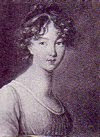
The main part of the lower half of The Garment is finished and has been sent to my model for a fitting. He is 6’2”, hence the long legs. The foot sections will be knit down from the ankles.
The photo at left shows this part of TG in its final stages, minus the fall. The legs were knit in the round but then I switched to back and forth for the upper part. The open (not yet sewn) inner seam is just visible. Following the pattern of men’s breeches at that time, the seam is on the inside of the leg. There was an outside seam, too, but "it don't signify" in this case. This photo also shows several sets of needles on TG. The fall (front flap) is on a small circular needle and green wool, holding the stitches until the needle was put on but left on for clarity in the photo. This was knit back and forth with two garter stitches on either side and across the top to flatten the edges, and with a button hole at either upper side. Decreases were made on both sides for the waist as I knit up the hips, also, at this point, back and forth, with stitches both cast/bound off and some replaced, at the front for the waistband. The waist area shows two pairs of long circular needles. The larger, wooden set is knitting the outer waist band, including the stitches added for the front of the waistband which will also have a button. The thin, metal long circular needles are holding the stitches at the base of the waistband which will become the inner waistband, offering double support, therefore, to the upper part of TG which will be knit upwards from the lower part pictured here and from both waistbands, incorporated into one knitted row.








